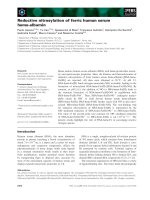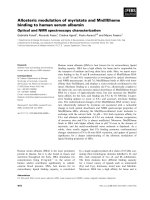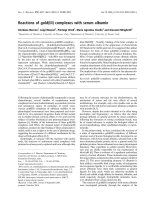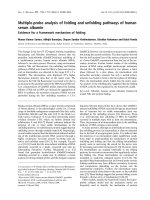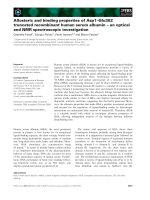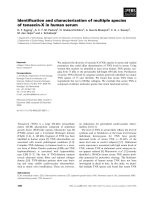Varicella vaccine without human serum albumin versus licensed varicella vaccine in children during the second year of life: A randomized, double-blind, non-inferiority trial
Bạn đang xem bản rút gọn của tài liệu. Xem và tải ngay bản đầy đủ của tài liệu tại đây (631.89 KB, 7 trang )
Prymula et al. BMC Pediatrics (2016) 16:7
DOI 10.1186/s12887-016-0546-5
RESEARCH ARTICLE
Open Access
Varicella vaccine without human serum
albumin versus licensed varicella vaccine
in children during the second year of life:
a randomized, double-blind, non-inferiority
trial
Roman Prymula1*, Robert Simko2, Michael Povey3 and Andrea Kulcsar4
Abstract
Background: GSK’s varicella vaccine contains human serum albumin (HSA) which is used to stabilize the virus and
prevent immunogens from adhering to the injection vial walls. However, because HSA is derived from human
blood, there is a theoretical risk that it might contain infectious agents which could be unsafe for humans. Given
this concern, a study was undertaken to compare the immunogenicity and safety of a new formulation without
HSA with the currently licensed varicella vaccine in the Czech Republic and Hungary.
Methods: Healthy children aged 11–21 months received two doses of the varicella vaccine either with or
without HSA. Antibody titres against varicella-zoster virus (anti-VZV) were measured 42 days after each dose,
using an immunofluorescence assay (IFA, cut-off = 4dilution−1) and enzyme linked immunosorbent assay (ELISA,
cut-off = 25 mIU/ml). Solicited local symptoms were recorded during a 4-day post-vaccination follow-up period;
solicited general and unsolicited symptoms were recorded during a 43-day post-vaccination follow-up period and
serious adverse event (SAEs) were recorded throughout the study.
Results: Of 244 children (mean age = 15.2 months [SD = 3.2]) vaccinated in the study, 233 (vaccine without
HSA N = 117; vaccine containing HSA N = 116) formed the according-to-protocol immunogenicity cohort.
Observed seroconversion/seroresponse rates were >98 and 100 %, 42 days after doses 1 and 2, respectively.
The rates were within the same range in both groups, irrespective of the testing assay. The varicella vaccine
without HSA was non-inferior to the licensed vaccine in terms of anti-VZV antibody Geometric Mean Titre/
Concentration ratio (1.12 [95 % CI:0.86–1.46] by IFA; 1.12 [95 % CI:0.93–1.33] by ELISA) approximately six weeks
after the first dose of the 2-dose vaccination course. The incidence of solicited and unsolicited symptoms was
similar after both vaccines; low-grade fever was numerically higher after the first dose of the varicella vaccine
without HSA. Seven SAEs were reported, none of which were fatal or considered to be vaccine-related.
Conclusions: The first dose of a new varicella vaccine without HSA was immunologically non-inferior to the licensed
varicella vaccine. After two doses, both vaccines had acceptable safety profiles in children aged 11–21 months in the
Czech Republic and Hungary.
Trial registration: NCT00568334, registered on 5 December 2007 (www.clinicaltrials.gov).
Keywords: Varicella vaccine, Non-inferiority, Human serum albumin, HSA
* Correspondence:
1
Faculty of Military Health Sciences, University of Defence, Trebesska 1575,
50001 Hradec Kralove, Czech Republic
Full list of author information is available at the end of the article
© 2016 Prymula et al. Open Access This article is distributed under the terms of the Creative Commons Attribution 4.0
International License ( which permits unrestricted use, distribution, and
reproduction in any medium, provided you give appropriate credit to the original author(s) and the source, provide a link to
the Creative Commons license, and indicate if changes were made. The Creative Commons Public Domain Dedication waiver
( applies to the data made available in this article, unless otherwise stated.
Prymula et al. BMC Pediatrics (2016) 16:7
Background
In children, primary infection with varicella-zoster virus
(VZV) causes chicken pox [1], a highly contagious but
mostly benign disease. It can, however, be associated
with a range of serious complications such as secondary
bacterial infections, pneumonia, cerebellar ataxia, encephalitis and Reye’s syndrome [1]. In adolescents and
adults, primary VZV infection causes greater morbidity
and mortality [2]. Following primary VZV infection, the
latent virus persists in the central nervous system and
can be reactivated in later life to cause herpes zoster
(HZ) or shingles [2, 3]. Complications of HZ include
herpes ophthalmicus, cutaneous dissemination, pneumonia and other central nervous system, pulmonary, hepatic and pancreatic complications [4].
In Europe, over 90 % of children contract chicken pox
in the first 12 years of life [5–9]. Although the reported incidence of VZV-related deaths (≤0.05/100,000 population/
year) and hospitalizations (1.1–18.7/100,000 population/
year) in European countries is low, the burden of disease
is nevertheless significant [10–12].
Two monovalent varicella vaccines are currently available in Europe: Varilrix™ (GSK Vaccines) and Varivax™
(Merck & Co. Inc), both of which are derived from the
Japanese Oka strain. Placebo-controlled clinical trials
have demonstrated that both vaccines are immunogenic,
safe and efficacious [13, 14]. A recent observer-blind
study in Europe showed 65.4 % efficacy for one varicella
vaccine dose at preventing confirmed varicella of any severity, and 90.7 % efficacy at preventing moderate to severe cases during 3 years of follow-up [15].
Since the World Health Organization recommendation for routine vaccination against childhood VZV infection in 1998 [16], several countries have implemented
either of the varicella vaccines into their national
immunization programs [17–24]. By 2008, the human
serum albumin (HSA)-containing varicella vaccine
(Varilrix™) was licensed in 92 countries [25].
HSA is incorporated in live, attenuated vaccines to
stabilize the virus and prevent immunogens from adhering to the walls of the injection vial. However, because
HSA is a protein derived from human blood, there is a
theoretical risk that it might contain infectious agents
[26] which could make it unsafe for humans. Given this
concern, the manufacturing process has been modified
to remove HSA from the vaccine stabilizer added towards the end of production. This is in line with the
European Medicines Agency recommendation to eliminate all blood-derived products of human origin from
vaccine manufacturing [27]. This study was therefore
undertaken to confirm that the varicella vaccine without
HSA was immunologically non-inferior to the licensed
varicella vaccine. The safety profile of both vaccines was
also assessed despite the process change.
Page 2 of 7
Methods
Study design and subjects
This phase II, non-inferiority study was conducted at 14
centres (offices of primary care physicians and general
practitioners) in the Czech Republic (2 centres) and
Hungary (12 centres) between November 2007 and April
2008 (NCT00568334). The primary care physicians recruited children and depending on the centre, either the
physician/nurse administered the vaccine. The study was
carried out in a double-blind manner, meaning that the
investigators, study staff and parents/guardians of children were unaware of the vaccine given.
Healthy children 11–21 months of age were enrolled
and randomized (1:1) to receive either two doses of
varicella vaccine without HSA (Group A) or two doses of
varicella vaccine containing HSA, Varilrix™ (Group B)
which is licensed for the prevention of varicella in healthy
children from 9 months of age. The selection criteria in
this study were similar to previous studies conducted with
the licensed vaccine [28, 29]. The two doses were administered 42–56 days apart. Children were excluded from the
study if they had received any live attenuated viral routine
vaccines or investigational drug/vaccine within 30 days or
immunosuppressant/immune modifying drugs/blood-derived products within six months of receiving the study
vaccine. They were also excluded if they had been previously exposed to VZV or had: any confirmed or suspected
immunosuppressive condition; a family history of immunodeficiency; chronic illnesses, allergies to any vaccine
components or an acute disease at the time of enrolment.
In order to account for the multiple routine vaccinations
recommended at this age, children were allowed to receive
routine inactivated vaccines up to eight days before each
study vaccination so as to not interfere with the reactogenicity assessment after varicella vaccination. It was advised that children participating in the study should avoid
the use of aspirin for six weeks after vaccination as Reye’s
syndrome has been reported following the use of aspirin
during natural varicella infection.
All study-related documents including the study
protocol were reviewed and approved by the Pardubice
Regional Hospital and the Regional Hospital Nachod for
the two participating centres, respectively, in the Czech
Republic and by the Egészségügyi Tudományos Tanács
Klinikai Farmakológiai Etikai Bizottság for the 14 participating centres in Hungary. The study was conducted in
accordance with Good Clinical Practice, the Declaration
of Helsinki and all applicable regulatory requirements.
Parents/guardians provided written informed consent
before any study procedures were performed.
Study vaccines
Both varicella vaccines were developed and manufactured by GSK Vaccines, Belgium. The potency of the
Prymula et al. BMC Pediatrics (2016) 16:7
Oka/RIT strain in the licensed varicella vaccine was 104.4
plaque forming units (pfu)/0.5 mL compared with 104.3
pfu/0.5 mL in the formulation without HSA. Both
vaccines were presented as lyophilized pellets, which
were reconstituted with the supplied diluent before subcutaneous injection in the left upper arm.
Immunogenicity
Blood samples were collected immediately before vaccination and 42 days after each vaccine dose. Antibody
titres against VZV (anti-VZV) were measured using two
assays: a commercial enzyme linked immunosorbent
assay (ELISA kit, Enzygnost™, Dade Behring, Marburg,
Germany; assay cut-off = 25 mIU/ml) and an immunofluorescence assay (IFA, Virgo™, Hemagen Diagnostics,
Columbia, MD, USA; assay cut-off = 4dilution−1).
Safety
Parents/guardians used diary cards to record solicited
local and general symptoms and unsolicited adverse
events. Solicited local symptoms around the injection site
(pain, redness and swelling) were recorded for four days
after each dose and solicited general symptoms (fever
[axillary temperature ≥37.5 °C/rectal temperature ≥38 °C]
and rash/exanthema) were recorded for 43 days after each
dose. Body temperature was measured daily via the rectal/
axillary route for eight days after each vaccine dose.
Between days 8–42, the presence of fever was monitored
using a temperature-sensitive forehead thermometer
(FeverScan™, LCR Hallcrest, UK). If the forehead thermometer indicated fever, temperature was accurately measured using a thermometer and recorded.
The intensity of solicited symptoms was graded on
a scale of 0–3. Grade 3 solicited symptoms were defined as: child cried when limb was moved or a
spontaneously painful limb (pain); injection site surface diameter >20 mm (redness and swelling); axillary temperature >39 °C/rectal temperature >39.5 °C
(fever) and ≥150 lesions (rash/exanthema).
Unsolicited symptoms were recorded for 43 days after
each dose and were classified as Grade 3 if they prevented everyday activity. Serious adverse events (SAEs)
were recorded throughout the study.
Statistical analysis
All statistical analyses were performed using SAS 9.1
and Proc StatXact 7.0 [30, 31].
The primary objective of the study was to demonstrate
non-inferiority of the first dose of the varicella vaccine
without HSA when compared to the licensed vaccine.
This was achieved if the lower limits (LL) of the two-sided
standardized asymptotic 95 % confidence intervals (CI) for
the Geometric Mean Titre (GMT) ratio between the vaccine without HSA and the licensed vaccine was ≥0.5
Page 3 of 7
(measured by IFA) and the Geometric Mean Concentration (GMC) ratio between two groups was ≥0.67 (measured by ELISA). The sample size calculated based on
non-inferiority of immunogenicity and a sample size of
approximately 100 subjects for each treatment group rendered 92 % power to the analyses. The analysis of safety
data was descriptive.
A central randomization system, using a minimization
algorithm, provided each child with a unique treatment
number. After randomization, a central blocking scheme
was used to ensure that the balance between treaments
was maintained.
Immunogenicity analysis was conducted on the
according-to-protocol (ATP) cohort for immunogenicity,
which included all subjects for whom both pre- and
post-vaccination data were available for both vaccine
doses, who were seronegative (anti-VZV antibody titre
below the assay cut-off ) for anti-VZV antibodies before
vaccination, and complied with study procedures. The
analysis of safety was conducted on the total vaccinated
cohort (TVC) which included all subjects who received
at least one dose of study vaccine.
Seroconversion (IFA data) was defined as an anti-VZV
antibody titre ≥ the assay cut-off value (4dilution−1) in previously seronegative subjects. Seroresponse (ELISA data)
was defined as an antibody concentration ≥ the assay cutoff (25 mIU/mL) in previously seronegative subjects.
The percentage of subjects who showed seroconversion or seroresponse after both vaccine doses was calculated with 95 % CI. The corresponding anti-VZV GMT/
GMC values were calculated with 95 % CI by taking the
anti-log of the mean of the log of titre/concentration
transformations. Values below the cut-off were given
arbitrary values of half the cut-off for the purpose of this
study. The GMT/GMC ratio was calculated using an
analysis of variance. The ratio and 95 % CI were calculated as an exponential transformation of the values. A
two-sided standardized asymptotic 95 % CI was calculated on the difference in the percentage of subjects with
anti-VZV antibody concentrations ≥50 mIU/ml.
Results
Baseline characteristics
A total of 244 subjects were enrolled (122 in each group)
of whom 233 were included in the ATP immunogenicity
cohort (Group A = 117; Group B = 116; Fig. 1). The
baseline characteristics were similar between the groups
(Table 1). The mean age of the children in the TVC was
15.2 months (standard deviation [SD]: ±3.2), 51.2 % were
male, and all were Caucasian.
Immunogenicity
The proportion of initially seropositive individuals was
0.8 % in Group A and 3.3 % in Group B when antibody
Prymula et al. BMC Pediatrics (2016) 16:7
Page 4 of 7
Fig. 1 Participant Flowchart
titres/concentrations were analyzed by IFA, compared
with 0.8 % in both groups when analysed using ELISA.
Six weeks post-dose-1, the seroconversion rates, as
measured by IFA, were similar in Group A (98.3 %
[95 % CI: 93.9–99.8 %]) and B (99.1 % [95 % CI: 95.3–
100 %]) (Table 2). Post-dose-2 seroconversion rates were
100 % in both groups. After dose-1, 90.5 % (95 % CI:
83.7–95.2 %) subjects in Group A and 89.6 % (95 % CI:
Table 1 Baseline characteristics (total vaccinated cohort N = 244)
Characteristic
Age (months)
Gender (n [%])
Group A
(N = 122)
Group B
(N = 122)
Total
(N = 244)
Mean
15.6
14.8
15.2
SD
3.3
3.1
3.2
Male
63 (51.6)
62 (50.8)
125 (51.2)
Female
59 (48.4)
60 (49.2)
119 (48.8)
Group A: varicella vaccine without HSA administered according to a
two-dose regimen
Group B: licensed varicella vaccine administered according to a
two-dose regimen
N: total number of subjects
n (%): number (percentage) of subjects in each category
SD: standard deviation
82.5–94.5 %) in Group B had concentrations of antiVZV antibodies ≥50 mIU/ml.
Six weeks post-dose-1, the seroresponse rates as measured by ELISA, were 98.3 % in Groups A and B (Table 2).
Six weeks post-dose-2, the seroresponse rates were 100 %
in both groups.
The primary non-inferiority criteria post-dose-1 was
achieved since the LL of the 95 % CI between the vaccine without HSA and licensed varicella vaccine were:
0.86 for the GMT ratio by IFA (i.e. ≥ the pre-defined
clinical limit of 0.5); and 0.93 for the GMC ratio by
ELISA (i.e. ≥ the pre-defined clinical limit of 0.67).
Safety and reactogenicity
The incidence of solicited and unsolicited symptoms,
43 days post-dose-1 was: 76 % in Group A and 69.7 % in
Group B; post-dose-2, the incidence was 71.9 and
68.6 %, respectively.
Injection site redness was the most common solicited
local symptom (any and Grade 3) in both groups after
both doses (Fig. 2). During the eight days of active
follow-up after dose-1 when temperature was monitored
Prymula et al. BMC Pediatrics (2016) 16:7
Page 5 of 7
Table 2 Immunogenicity of vaccine without HSA and licensed varicella vaccines six weeks after doses 1 and 2 (according-toprotocol immunogenicity cohort N = 233)
Dose
Group A
Varicella vaccine without HSA
Group B
Licensed varicella vaccine
Ratio (Group A/Group B)
Post-dose 1
N
SC % (95 % CI)
GMT (95 % CI)
N
SC (95 % CI)
GMT (95 % CI)
GMT (95 % CI)
6 weeks Post-dose 1
116
98.3 (93.9; 99.8)
172.6 (141.6; 210.3)
115
99.1 (95.3; 100)
154.3(128.7; 185.0)
1.12 (0.86; 1.46)
6 weeks Post-dose 2
115
100 (96.8; 100)
1452.5 (1240.7; 1700.5)
112
100 (96.8; 100)
1395.4 (1183.0; 1645.9)
Dose
N
SR (95 % CI)
GMC (95 % CI)
N
SR (95 % CI)
GMC (95 % CI)
GMC (95 % CI)
6 weeks Post-dose 1
116
98.3 (93.9; 99.8)
123.5(107.9; 141.4)
115
98.3 (93.9; 99.8)
110.7 (98.4; 124.6)
1.12 (0.93; 1.33)
6 weeks Post-dose 2
116
100 (96.9; 100)
1013.6 (880.9; 1166.4)
114
100 (96.8;100)
999.2 (877.3; 1138.1)
IFA
ELISA
N: total number of subjects
95 % CI: 95 % confidence interval
SC %: seroconversion rate
SR %: Seroresponse rate
GMT: geometric mean antibody titre calculated on all subjects by IFA
GMC: geometric mean antibody concentration calculated on all subjects by ELISA
Criteria for non-inferiority:
The lower limit of the 95 % confidence interval (CI) for the GMT ratio (derived by IFA) between Group A and Group B is equal to or above the pre-defined clinical
limit of 0.5
The lower limit of the 95 % CI for the GMC ratio (derived from ELISA) between Group A and Group B is equal to or above the pre-defined clinical limit of 0.67
daily, the fever rate in Group A was 28.1 % (95 % CI: 20.3–
37.0 %) and 18.0 % (95 % CI: 11.7–26.0 %) in Group B.
Post-dose-1, Grade 3 fever occurred in four subjects in
Group A and two subjects in Group B. Post-dose-2, fever
was recorded in 25.6 % (95 % CI: 18.1–34.4 %) of Group A
subjects and 19 % (95 % CI: 12.4–27.1 %) of Group B subjects. Grade 3 fever, post-dose-2 occurred in one subject in
Group A and two subjects in Group B. The observed
incidence of fever during the 43 days of follow up postdose-1 was also numerically higher in Group A (52.9 %
[95 % CI: 43.6–62 %]) as compared with Group B (42.6 %
[95 % CI: 33.7–51.9 %]) (Fig. 2), although the exact 95 %
CIs rates were overlapping.
During the 43-day follow-up period post-dose-1,
rash/exanthema was seen in 2.5 % (95 % CI: 0.5–7.1 %)
subjects in Group A subjects compared with 3.3 %
Fig. 2 Solicited local (4-days post-vaccination) and general symptoms (43 days post-vaccination) (Total Vaccinated Cohort N = 244). %: percentage
of subjects reporting the symptom at least once. 95 % CI: Exact 95 % confidence interval; Grade 3 pain: Cried when limb was moved/spontaneously
painful; Grade 3 Redness/swelling >20.0 mm; Grade 3 Fever >39.0 °C; Grade 3 Rash >150 lesions
Prymula et al. BMC Pediatrics (2016) 16:7
(95 % CI: 0.9–8.2 %) in Group B. During the 43-day
follow-up period after the second dose, the observed
incidence of any type of rash was 5.8 % (95 % CI: 2.4–
11.6 %) in Group A and 2.5 % (95 % CI: 0.5–7.1 %) in
Group B (Fig. 2).
At least one unsolicited symptom was reported in
45.9 % Group A versus 36.9 % Group B subjects during
the 43-days post-dose-1 follow-up period. The most
common unsolicited symptom in Group A was bronchitis (12.3 %; n = 15) and viral infection with fever in
Group B (9.0 %; n = 11). Over the 43-day post-dose 2
follow-up period, unsolicited symptoms were recorded
in 28.9 and 34.7 % of subjects in Groups A and B, respectively. The most common symptom was bronchitis
(6.6 % [n = 8] and 9.1 % [n = 13], respectively).
Seven subjects, two in Group A and five in Group B
recorded the following SAEs: otitis media and laryngitis
(each accounting for two cases), gastroenteritis, concussion, bronchitis, breath holding attack, mastoiditis and
sinusitis. One child experienced three SAEs (mastoiditis,
otitis media and sinusitis). None of the SAEs were fatal
and all were considered unrelated to vaccination.
Discussion
The European Medicines Agency has advised vaccine
manufacturers to gradually eliminate the use of blood derived products of human origin because of a theoretical
risk of contamination [27, 32]. This phase II study conducted in the Czech Republic and Hungary compared the
immunogenicity and safety of a varicella vaccine without
HSA (developed to comply with the EMA guidance) with
that of the licensed varicella vaccine in children below two
years of age. After one dose, the immune responses elicited
by the varicella vaccine without HSA were non-inferior to
those elicited by the licensed varicella vaccine, i.e. the LL
of the two-sided standardized asymptotic 95 % CI for the
between-vaccine IFA-measured GMT ratio was ≥0.5 and
for the ELISA-measured GMC ratio was ≥0.67.
One of the most important characteristics for paediatric
vaccine development is safety, especially as it is essential
to maintain high vaccination coverage to control disease.
We utilized two assays in this study: IFA, the serologic
method used to license the original varicella vaccine and
ELISA. The latter test has improved performance characteristics over IFA, i.e. ELISA is more sensitive and can
detect lower titres in samples [33, 34]; data from this
study could also be used to support a switch to ELISA
[33, 34]. In the current study, 43 days after both doses of
each vaccine were administered, the seroconversion/seroresponse rates for anti-VZV antibodies were above 98 %, irrespective of which assay was used. These rates are
consistent with pre-licensure European studies with the licensed varicella vaccine in which age-stratified children
(15 months–2 years and 2–6 years) achieved average
Page 6 of 7
seroconversion rates of 97 % [35] and a more recent study
from Indonesia where children aged 10 months–12 years
demonstrated a seroconversion rate of 97 % to the licensed
varicella vaccine [36].
A numerical (but not statistically significant) increase in
the incidence of fever was observed following the administration of the first dose of the vaccine without HSA as
compared to the HSA-containing vaccine. This difference
appeared to be driven by an increase in fever in the group
receiving the vaccine without HSA as compared to the
HSA-containing group within eight days post-vaccination.
The difference was only observed in low grade fever; no
difference in high grade fever (>39 °C) was noted. It is unlikely that this increase in low grade fever might have any
significant clinical implications.
The results of this study should be interpreted with
caution. First, the comparison between IFA and ELISA
assays was not an objective of this study and therefore is
primarily descriptive. Second, the sample size was not
calculated for the analysis of safety and while we discuss
the differences in fever rates between the two vaccines,
we cannot draw strong conclusions based on it. Third,
administering varicella vaccines with other routine vaccines would have presented a more complete view and
further research may be required.
Conclusion
The first dose of a new varicella vaccine without HSA
was immunologically non-inferior to the licensed varicella vaccine. Two doses of the varicella vaccine had an
acceptable safety profile in children aged 11–21 months
in the Czech Republic and Hungary. We utilized two assays in this study because the ELISA test has reputed
improved performance characteristics over the IFA and
to support a future switch to ELISA.
Abbreviations
ATP: According-to-protocol; CI: Confidence interval; ELISA: Enzyme linked
immunosorbent assay; GMC: Geometric mean concentration;
GMT: Geometric mean titre; HSA: Human serum albumin; HZ: Herpes zoster;
IFA: Immunoflourescence assay; LL: Lower limit; SAE: Serious adverse events;
TVC: Total vaccinated cohort; VZV: Varicella-zoster virus.
Competing interests
Dr. Roman Prymula received grants for conducting this trial and personal
fees from the GSK group of companies, and also received grants from Pfizer,
Sanofi-Pasteur, Baxter, Merck & Co., Inc and GSK group of companies outside
the scope of the submitted work. Dr. Andrea Kulcsar received payment for
lectures and articles from Novartis, Pfizer, Sanofi-Pasteur and the GSK group of
companies. Michael Povey is an employee of the GSK group of companies. Dr.
Robert Simko received payment as the principal investigator of the clinical trial.
Authors’ contribution
RP, AK and RS were investigators on the clinical trial. RP and AK conceptualized
and designed the study as well as assembling and collecting data. RP was also
involved in choosing the centres and recruiting investigators. RS participated in
interpreting the data. MP supervised the analysis and provided statistical
expertise to interpret the data. All authors critically reviewed and approved the
manuscript at all stages of development.
Prymula et al. BMC Pediatrics (2016) 16:7
Acknowledgments
The authors would like to thank all the investigators involved in this trial. In
addition, the authors acknowledge Ouzama Henry and Carmen Baccarini for
their expert input and critical review of the manuscript, Preethi Govindarajan
for medical writing, Julia Donnelly (freelance on behalf of GSK group of
companies) for language editing, and Shruti MP and Ashmita Ravishankar for
publication coordination (employed by GSK group of companies).
Page 7 of 7
16.
17.
18.
Funding
This study was sponsored and funded by GlaxoSmithKline Biologicals SA,
Rixensart, Belgium. GlaxoSmithKline Biologicals SA was involved in all stages
of the study conduct and analysis and also took charge of all costs associated
with the development and the publishing of this manuscript.
Trademark
Virgo is a registered trademark of Hemagen Diagnostics, Columbia, MD, USA.
Enzygnost is a registered trademark of Dade Behring, Marburg, Germany
Varilrix is a registered trademark of GSK group of companies
Varivax is a registered trademark of Merck & Co.In, USA.
Author details
1
Faculty of Military Health Sciences, University of Defence, Trebesska 1575,
50001 Hradec Kralove, Czech Republic. 2Primary Care Paediatric Praxis, No 8,
Miskolc, Hungary. 3GSK Vaccines, Avenue Fleming 20 B-1300, Wavre, Belgium.
4
Szent László Hospital, Gyali Street 5-7, Budapest 1097, Hungary.
Received: 28 November 2014 Accepted: 8 January 2016
References
1. Lopez A, Schmid S, Bialek S: VPD Surveillance Manual: Varicella [http://www.
cdc.gov/vaccines/pubs/surv-manual/chpt17-varicella.pdf]. Accessed 21 May,
2014.
2. Vaccines and Immunizations: Varicella [ />pinkbook/varicella.html]. Accessed 21 May, 2014.
3. Shapiro M, Kvern B, Watson P, Guenther L, McElhaney J, McGeer A. Update
on herpes zoster vaccination: a family practitioner’s guide. Can Fam Physician.
2011;57:1127–31.
4. Marin M, Güris D, Chaves SS, Schmid S, Seward JF, Advisory Committee on
Immunization Practices, Centers for Disease Control and Prevention (CDC).
Prevention of varicella: recommendations of advisory committee on
immunization practices (ACIP). MMRV Recomm Rep. 2007;56:1–40.
5. Aebi C, Fischer K, Gorgievski M, Matter L, Muhlemann K. Age-specific
seroprevalence to varicella-zoster virus: study in Swiss children and analysis
of European data. Vaccine. 2001;19:3097–103.
6. Gabutti G, Penna C, Rossi M, Salmaso S, Rota MC, Bella A, et al. The
seroepidemiology of varicella in Italy. Epidemiol Infect. 2001;126:433–40.
7. Kanra G, Tezcan S, Badur S, Turkish National Study Team. Varicella
seroprevalence in a random sample of the Turkish population. Vaccine.
2002;20:1425–8.
8. Schmitt HJ, Booy R, Weil-Olivier C, Van Damme P, Cohen R, Peltola H. Child
vaccination policies in Europe: a report from the summits of independent
european vaccination experts. Lancet Infect Dis. 2003;3:103–8.
9. Thiry N, Beutels P, Shkedy Z, Vranckx R, Vandermeulen C, Wielen MV, et al.
The seroepidemiology of primary varicella-zoster virus infection in Flanders
(Belgium). Eur J Pediatr. 2002;161:588–93.
10. Sengupta N, Booy R, Schmitt HJ, Peltola H, Van-Damme P, Schumacher RF,
et al. Varicella vaccination in Europe: are we ready for a universal childhood
program? Eur J Pediatr. 2008;167:47–55.
11. Ciofi Degli Atti ML, Salmaso S, Bella A, Arigliani R, Gangemi M, Chiamenti G,
et al. Pediatric sentinel surveillance of vaccine-preventable diseases in Italy.
Pediatr Infect Dis J. 2002;21:763–8.
12. Pinot De Moira A, Nardone A, ESEN2 Group. Varicella Zoster Virus
Vaccination Policies and Surveillance Strategies in Europe. Euro Surveill.
2005;10:43–4.
13. Gershon A, Takahashi M, Seward J. Varicella vaccine. In: Plotkin SA, Orenstein
WA, editors. Vaccines. 4th ed. Philadelphia (PA): Saunders; 2004. p. 783–825.
14. Skull SA, Wang EE. Varicella vaccination: a critical review of the evidence.
Arch Dis Child. 2001;85:83–90.
15. Prymula R, Bergsaker MR, Esposito S, Gothefors L, Man S, Snegova N, et al.
Protection against varicella with two doses of combined measles-mumps-
19.
20.
21.
22.
23.
24.
25.
26.
27.
28.
29.
30.
31.
32.
33.
34.
35.
36.
rubella-varicella vaccine versus one dose of monovalent varicella vaccine:
a multicentre, observer-blind, randomised, controlled trial. Lancet. 2014;383:
1313–24.
World Health Organization. The WHO position paper on varicella vaccines.
Wkly Epidemiol Rec. 1998;73:241–8.
Macartney KK, Burgess MA. Varicella vaccination in Australia and New
Zealand. J Infect Dis. 2008;197 Suppl 2:S191–5.
National Advisory Committee on Immunization. National Advisory
Committee on Immunization (NACI) update on varicella. Can Commun
Dis Rep. 2004;30:1–26.
Childhood immunization calendar, Greece [c.
europa.eu/Pages/Scheduler.aspx]. Accessed 9 May, 2014.
Sadzot-Delvaux C, Rentier B, Wutzler P, Asano Y, Suga S, Yoshikawa T, et al.
Varicella vaccination in Japan, South Korea and Europe. J Infect Dis. 2008;
197:185–90.
Quian J, Ruttimann R, Romero C, Dall’orso P, Cerisola A, Breuer T, et al. Impact
of universal varicella vaccination of one year-olds in Uruguay: 1997–2005.
Arch Dis Child. 2008;93:845–50.
WHO vaccine preventable disease monitoring system: Immunization
schedules by antigen, selection centre [ />monitoring/globalsummary/schedules]. Accessed 9 May, 2014.
Liao SL, Huang T, Huang YC, Jiang DD. Survey of the status of self-paid
varicella vaccination among children one to six years of age in Taiwan.
J Microbiol Immunol Infect. 2007;40:112–5.
Reynolds MA, Watson BM, Plott-Adams KK, Jumaan AO, Galil K, Maupin TJ,
et al. Epidemiology of varicella hospitalizations in the United States, 1995–2005.
J Infect Dis. 2008;197:120–6.
Kreth HW, Lee BW, Kosuwon P, Salazar J, Gloriani-Barzaga N, Bock HL, et al.
Sixteen years of global experience with the first refrigerator-stable varicella
vaccine (Varilrix). BioDrugs. 2008;22:387–402.
Offit PA, Jew RK. Addressing parents’ concerns: do vaccines contain harmful
preservatives, adjuvants, additives, or residuals? Pediatr. 2003;112:1394–7.
EMA: The European Agency for the Evaluation of Medicinal Products: Note
for Guidance on Plasma-Derived Medicinal Products. 2001. [http://www.
ema.europa.eu/docs/en_GB/document_library/Scientific_guideline/2009/09/
WC500003613.pdf] Accessed 7 October, 2015.
Lau YL, Vessey SJ, Chan IS, Lee TL, Huang LM, Lee CY, et al. A comparison of
safety, tolerability and immunogenicity of Oka/Merck varicella vaccine and
VARILRIX™ in healthy children. Vacc. 2002;20(23–24):2942–9.
Schuster V, Otto W, Maurer L, Tcherepnine P, Pfletschinger U, Kindler K, et al.
Immunogenicity and Safety Assessments After One and Two Doses of a
Refrigerator-Stable Tetravalent Measles-Mumps-Rubella-Varicella Vaccine in
Healthy Children During the Second Year of Life. Pediatr Infect Dis J. 2008;
27(8):724–30.
Clopper CJ, Pearson ES. The use of confidence or fiducial limits illustrated in
the case of binomial. Biometrika. 1934;26:404–13.
Newcombe RG. Interval estimation for the difference between independent
proportions: Comparison of eleven methods. Statist Med. 1998;17:873–90.
EMEA–CHMP. EMEA–CHMP: Position Statement on Creutzfeldt–Jakob
Disease and Plasma-derived and Urine-derived Medicinal Products (2004).
[ />statement/2011/06/WC500108071.pdf]. Accessed 9 May, 2014.
Deedler AM, Kornelis D. A comparison of the IFA and the ELISA for the
demonstration of antibodies against Schistosome gut-associated
polysaccharide antigens in Schistosomiasis. Parasite Res. 1980;64:65–75.
Yahara Y, Okhubo Y, Kariwa H, Takashima I. Evaluation of enzyme-linked
immunosorbent assay (ELISA) and immunofluorescent antibody (IFA) test for
the detection of porcine reproductive and respiratory syndrome virus (PRRSV)
antibody in pigs from conventional farms. J Vet Med Science. 2002;64:583–8.
Gillet Y, Steri GC, Behre U, Arsène JP, Lanse X, Helm K, et al. Immunogenicity
and safety of measles-mumps-rubella-varicella (MMRV) vaccine followed by
one dose of varicella vaccine in children aged 15 months–2 years or 2–6
years primed with measles-mumps-rubella (MMR) vaccine. Vaccine.
2009;27:446–53.
Hadinegoro SR, Hindra IS, Han HH, Gatchalian S, Bock HL. Reactogenicity
and immunogenicity of a live-attenuated refrigerator-stable varicella vaccine
(OKA strain) in healthy seronegative children age 10 months to 12 years.
Southeast Asian J Trop Med Public Health. 2009;40:991.
